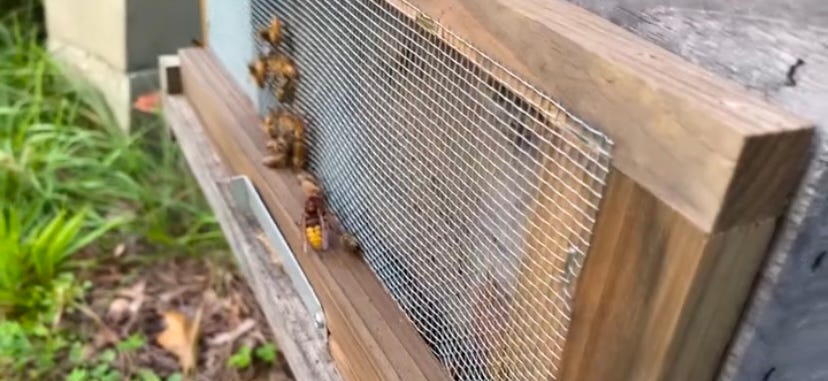3 ways to save money when keeping bees
Beekeeping isn’t cheap. Today I have a few ways of keeping costs down without compromising colony health.
Reminder: I have 3 hives for sale. If you’re a paid subscriber of this blog, you enjoy 10% off. If you’re in my mentorship program, you can get up to 50% off. Price includes a 1-year-old laying queen that’s descended from Chatham County, North Carolina genetics over the past 8 years, workers, and drawn comb on medium frames. Delivery options available.
5-frame nuc $225
10 frames $300
20 frames $350
Last week I shared about the cost of replacing a hive, which I believe can be hard (if not impossible) to value if you’ve lost genetics you’ve fostered for years. When managing hives, the ceiling of expenses can rise higher and higher. Some folks look for ways to cut corners whether they have the budget or not, but sometimes the things we choose to not spend money on come with a greater cost than what we would have spent.
When I first started beekeeping, our local club had a speaker whose job was to manage a sideliner’s operation. I remember him referencing entrance reducers and saying that he doesn’t use them because, in his words, “Why spend $2.00 per colony?” (Entrance reducers cost a little more today, but are still nominally priced IMO.) I thought he was being sarcastic, but realized he was serious. A few months later, I heard the sideliner fired him because a large number of the colonies had failed—I think because they were robbed out. I heard everything third-hand, so I can only speculate that the guy likely skimped on other equipment and practices with the same regard he had for entrance reducers. Not only did his frugality cost him his job, and lost business for his employer, but the lives of tens of thousands of bees too.
I think the sideliner employee story is a great example of how spending a little can save a lot, which is where my first tip comes in:
Invest. Spend money strategically on equipment that will pay dividends. Whether you choose entrance reducers or robbing screens for all colonies, or an oxalic acid vaporizer that you can use over and over for years to come—think about your goals, values, and the long-term savings. For instance, once you have an oxalic acid vaporizer, each mite treatment costs pennies. As of this writing, a vaporizer costs approximately $40. (I was surprised to see how low the prices have come. When I started beekeeping in 2017, these vaporizers were $150+.) A 2-lb bag of oxalic acid costs $16. For a treatment, each hive needs a few grams or less, depending on its size. Investing a little up front means lower ongoing costs. It can be even lower if you share – which is my next tip.
Borrow or create a bee tool library. My beekeeping mentor and I share some equipment. When I have a split, swarm, or my hives are moving broodless into winter—I opt to do an oxalic acid treatment to knock down mites. My mentor owns a vaporizer, so I’ll pick it up from him. If you haven’t used a vaporizer, most rely on a lawnmower or motorcycle battery for power. When you’re treating several hives, the current from a battery isn’t always consistent. I struggled with failed treatments because of battery issues—which was extremely frustrating because so many variables come into play when I choose to treat: brood must be absent or uncapped, weather needs to cooperate, I prefer to treat at sunrise when majority of the colony is present, and my own personal schedule needs to align. If I can’t do what I need to do, it’s a waste of time. My husband—always a problem-solver—suggested that he modify the vaporizer to add a regular outlet plug. That way I could plug directly into power and have a consistent current. My husband made all the modifications, so my mentor has a dual-power vaporizer at no cost (our expense) while I get to borrow the vaporizer at no cost.
I also borrow my mentor’s honey extractor. While vaporizers appear to have gone down in price, extractors have gone up. I saw a similar extractor at a bee supply store last year and it’s about $2,000. Many bee clubs have an extractor that they rent out for low fees. Creating a “tool library” of bee supplies can help crowdshare costs and allow folks use of equipment that they may otherwise not be able to buy on their own or store in their space.
Bee boundaries. Generally, most hives that survive winter will swarm the following spring—if left without intervention. Splitting to prevent a swarm, or catching the swarm, means 1 hive becomes 2 and that means double the expenses. A few beekeeper friends of mine on the other side of town were able to grasp the potential stress and expense when they got started, and they decided never to have more than 2 colonies at once. I admire their ability to set bee boundaries. They know they need a certain amount of equipment, so now that they’re fully stocked they don’t have much of an ongoing expense other than maintenance, replacement, and treatments. I’m still learning bee boundaries, which is why I’m offering hives for sale. I know I need to keep the number of hives I manage to a reasonable amount.
There are many other ways to save money when keeping bees, like building your own equipment and catching swarms instead of buying packages or nucs. On the flipside, I enjoy NOT building my own equipment and value the time freedom that comes with the expense of buying my equipment already made. Any effort of saving money comes down to values. How are you incorporating your own values when it comes to the bees?




